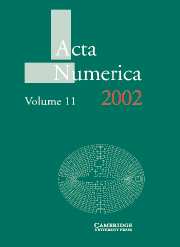Book contents
- Frontmatter
- Contents
- 1 Structured inverse eigenvalue problems
- 2 Subdivision schemes in geometric modelling
- 3 Adjoint methods for PDEs: a posteriori error analysis and postprocessing by duality
- 4 Finite elements in computational electromagnetism
- 5 Splitting methods
- 6 Topological techniques for efficient rigorous computation in dynamics
- 7 The immersed boundary method
- 8 Numerical methods for large eigenvalue problems
1 - Structured inverse eigenvalue problems
Published online by Cambridge University Press: 21 May 2010
- Frontmatter
- Contents
- 1 Structured inverse eigenvalue problems
- 2 Subdivision schemes in geometric modelling
- 3 Adjoint methods for PDEs: a posteriori error analysis and postprocessing by duality
- 4 Finite elements in computational electromagnetism
- 5 Splitting methods
- 6 Topological techniques for efficient rigorous computation in dynamics
- 7 The immersed boundary method
- 8 Numerical methods for large eigenvalue problems
Summary
An inverse eigenvalue problem concerns the reconstruction of a structured matrix from prescribed spectral data. Such an inverse problem arises in many applications where parameters of a certain physical system are to be determined from the knowledge or expectation of its dynamical behaviour. Spectral information is entailed because the dynamical behaviour is often governed by the underlying natural frequencies and normal modes. Structural stipulation is designated because the physical system is often subject to some feasibility constraints. The spectral data involved may consist of complete or only partial information on eigenvalues or eigenvectors. The structure embodied by the matrices can take many forms. The objective of an inverse eigenvalue problem is to construct a matrix that maintains both the specific structure as well as the given spectral property. In this expository paper the emphasis is to provide an overview of the vast scope of this intriguing problem, treating some of its many applications, its mathematical properties, and a variety of numerical techniques.
Introduction
In his book Finite-Dimensional Vector Spaces, Halmos (1974) wrote:
Almost every combination of the adjectives proper, latent, characteristic, eigen and secular, with the nouns root, number and value, has been used in the literature for what we call a proper value.
This interesting comment on the nomenclature of eigenvalue echoes the enigmatic yet important role that eigenvalues play in nature. One instance, according to Parlett (1998), is that ‘Vibrations are everywhere, and so too are the eigenvalues associated with them.’
- Type
- Chapter
- Information
- Acta Numerica 2002 , pp. 1 - 72Publisher: Cambridge University PressPrint publication year: 2002
- 7
- Cited by



